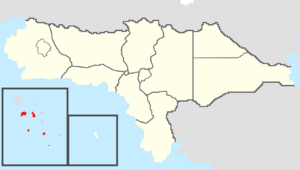Assimia
This article is incomplete because it is pending further input from participants, or it is a work-in-progress by one author. Please comment on this article's talk page to share your input, comments and questions. Note: To contribute to this article, you may need to seek help from the author(s) of this page. |
State of Assimia | |
|---|---|
State | |
| Nickname: The Islands State (official) | |
| Motto: | |
 Map of Rizealand with Assimia in red | |
| Country | |
| Before Statehood | Assimian Islands Territory |
| Capital (and largest city) | Pendleton |
| Joined Federation | August 21, 1980 (9th) |
| Government | |
| • Governor | Alex Kirkpatrick (NPC-ND) |
| • Deputy Governor | Josh Harvey (NPC-ND) |
| • Legislature | Assimia State Assembly |
| • Federal representation | Councilors
|
| Area | |
| • Total | 42,147.84 km2 (16,273.37 sq mi) |
| Population (2021) | |
| • Total | 2,910,542 |
| • Density | 69.06/km2 (178.9/sq mi) |
| Time zone | UTC+8 to +9 (Vehemens/Western) |
| Abbreviation | AM |
| ISO 3166 code | RZ-AM |
| Website | www |
Assimia, known officially as the State of Assimia, is a state located off the western coast of Rizealand in the Assimian Islands. Assimia has a total area of 42,147.84 square kilometers, making it the smallest state and tenth largest political division of Rizealand. Assimia also has a population of 2,910,542, making it the least populous state and ninth most populous political entity in Rizealand. Assimia's capital and largest city is Pendleton. Assimia is the only state and one of only two political divisions to be non-contiguous with the rest of Rizealand. It is also the most recent state to be admitted to the federation, having achieved statehood in 1980.
Etymology
The name of the State of Assimia is derived from the Assimian Islands, where it is located. Like the Assimas Islands, the Assimian Islands are named after Assim Asteris, the Caldian explorer who discovered Asteria Superior. Originally organized as the Assimian Islands Territory, advocates for statehood thought the name "State of the Assimian Islands" was too long and unwieldly, preferring a shorter and more versatile name. Instead, they proposed "Assimia" as a shortened version and it was adopted when statehood was obtained in 1980.
Geography
Ecology
Climate
Conservation
Demographics
Population
Language
Religion
Health
Education
Urban Areas
Government and politics
The government of Assimia is established and organized according to the Constitution of Assimia. Because Assimia is a constituent state of Rizealand, the powers of its government are subject to certain limits by the Articles of Federation including the requirement of a democratic form of government and prohibitions on forming alliances with foreign governments, declaring war, raising or maintaining armies, establishing forms of currency, and placing unlawful restraints on interstate and international trade. In addition to constitutional restraints on state power, the Articles also allow the Central Assembly to enact legislation that can supersede state laws when involving national security, interstate commerce, foreign affairs, immigration, and the public's welfare. Like the federal government of Rizealand, the government of Assimia is divided into three branches of government.
The legislative branch consists of a unicameral State Assembly. The State Assembly's 50 seats are filled through closed party list proportional representation elections held every five years. As the state legislature, the State Assembly is responsible for enacting legislation and can do so with a simple majority, although a majority of two-thirds is required to enact super laws, override the veto of the Governor, or remove government officials from office. The State Assembly is also responsible for approving the Governor's executive nominations.
The executive branch is headed by the Governor and Deputy Governor, who are the heads of state and and government elected in statewide two-round direct elections at the same time as the State Assembly for five-year terms, with a two consecutive term limit. The Governor is responsible for signing legislation into law, nominating executive agency heads, appointing state judges, and enforcing the laws of the state.
The judicial branch consists of the High Court, Court of Appeals, superior courts, and justice courts. All justices and judges are nominated by the Assimia Commission on Judicial Nominations and appointed by the Governor for lifetime terms, subject to retention elections every five years. Justices of the peace are elected in two-round direct elections for five-year terms.
There are also independent agencies and commissions established by state super laws that do not neatly fit into any branch of government, as they often enforce state laws (executive), issue rules and regulations (legislative), and adjudicate cases or claims (judicial). While their agency heads or commission members are usually nominated or appointed by the Governor, they can only be removed from office through impeachment and removal by the State Assembly.
Assimia has a common law legal system with some Estmerish influences. In addition to the protections of the Articles of Federation, the Assimia Constitution also establishes additional protections and gives citizens the right to recall state officials, refer legislation to a referendum vote, enact legislation via an initiative vote, and approve amendments to the state constitution.



